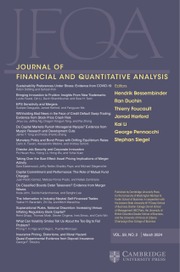No CrossRef data available.
Article contents
Competition Shocks, Rival Reactions, and Stock Return Comovement
Published online by Cambridge University Press: 18 February 2025
Abstract
To protect inframarginal rents, rivals react to competition shocks by increasing product differentiation or lowering costs by standardizing products and production processes. We test these two mutually exclusive reactions by exploiting changes in rivals’ idiosyncratic stock return comovement following significant tariff cuts. While increased product differentiation implies a reduction in return comovement, greater standardization implies the opposite (a comovement increase). Difference-in-differences (DID) tests indicate that tariff cuts cause a significant increase in return comovement—in particular among within-industry “followers.” Treatment effects on cash flows, product counts, similarity scores, and business segment counts further support cost-cutting strategies.
- Type
- Research Article
- Information
- Creative Commons
- This is an Open Access article, distributed under the terms of the Creative Commons Attribution licence (http://creativecommons.org/licenses/by/4.0), which permits unrestricted re-use, distribution and reproduction, provided the original article is properly cited.
- Copyright
- © The Author(s), 2025. Published by Cambridge University Press on behalf of the Michael G. Foster School of Business, University of Washington
Footnotes
We have benefitted from the comments and suggestions of Farooq Ahmad, Nihat Aktas, Sergey Chernenko (discussant), Jean-Gabriel Cousin, David Godsell, Davidson Heath (discussant), Gerard Hoberg (discussant), Michel Levasseur, Lars Persson (discussant), Gordon Phillips, and Karin Thorburn, as well as of seminar and conference participants at Aalto University, the University of Lille, American Finance Association, European Finance Association, European Association for Research in Industrial Economics, Finance Organizations and Markets Conference, Midwest Finance Association, Nordic Initiative for Corporate Economics Conference, Norwegian School of Economics, and WHU-Otto Beisheim School.


